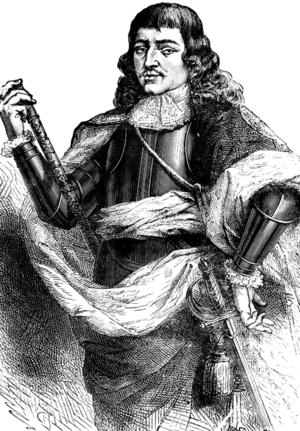Annotation:Monk's March
X: 1 T:Lord Monk's March, The T:General Monk's March B:Dancing Master, 3rd ed., supplement, 1657, via Barlow's book, 1985 S:Bruce Olson <olsonw@erols.com> irtrad-l 2000-09-03 Q:120 L:1/8 M:C| F:http://jc.tzo.net/~jc/music/abc/mirror/irtrad-l/Lord_Monks_March.abc K:Dm FD3 F4 | cA3 c4 | Ac(dc) A2 (GF)|(EF)(GF) E2(DC)| (FD3) F3d|(cA3) f4 | e4 (d^c)(de)|^c(A3 A4) :| g4 a4 | f3c (dc)(AF)| G4 d4 | G6 (AB)| (cd)(cA) c3A|(GE)CE G3E |(FG)(FD) (cd)(cA) | F(D3 D4) :|
MONK'S MARCH. AKA and see "General Monk's Goosestep," "Lord Monk's March," "Review (2) (The)," "Belle Isle's March." English, Morris Dance Tune (4/4 time). G Major (most versions): F Major (Thomas). Standard tuning (fiddle). AAB (Carlin): AABB (x4), AA (Mallinson): AABA (x4) AA (Bacon): ABCD (Thomas). Kidson (Groves) says a tune by this name first appears in Playford's Dancing Master of 1665 as "The Lord Monks March"; however, it was actually introduced in the supplement to the 3rd edition of the Dancing Master (1657). It also appears in Playford's Musicks Hand-Maid: New Lessons and Instructions (1678). Later versions were printed with another part inlcuded ("The Wanders") for which see "Monk's March with the Wanders." The melody in tradition with the name "Mon(c)k's March" was collected from dancers in the village Sherborne, Gloucestershire, in England's Cotswolds, and, as "General Monk's March," at Bledington[1]. The tune is still popular in English sessions in modern times, although considered to be a 'beginner's tune'. The dance itself is a heel-and-toe step dance which is said to be a satire on a Colonel or General George Monck wikipedia:George_Monck,_1st_Duke_of_Albemarle, who, while he sympathized with the Royalist cause during the English Civil War, fought on the side of Cromwell's Roundheads. The story goes that Monck resolved his moral conflict by marching to battle so slowly that he missed each conflict. In fact, Monck skillfully played a political game for his entire adult life, ending up with a reputation as one of England's greatest warriors. Soon after the Restoration, Charles II raised him to the Peerage as Duke of Albemarle, Earl of Torrington, in the County of Devon.

In Wales the same tune is known as well as "Flaunting Two" (printed in 1794), and also as "Hemp Dressers (The)" and a minor key version called "The Monks March." Regarding the latter title, a note in Edward Jones's 1784 collection noted the it was "probably" the tune of the Monks of Bangor, when they marched to Chester in 603. Jones's suggestion became a certainty with later editors, who even called it "The Monks of Bangor March," and Scottish publisher George Thomson managed to get Sir Walter Scott to write a poem for the air dealing with the massacre of the monks. In fact, there is no Welsh provenance for this air, printed more than 100 years earlier in London by Playford.
Another variant of the melody is the Northumbrian "Proudlock's Hornpipe." Regarding the alternate title "Belle Isle's March," Kate Van Winkler Keller (1992) suggests it may refer to the small island of Belle-Île-en-Mer, located off the coast of Brittany, that was occupied by the British from 1761 to 1763. The march was published in a song-sheet under the "Bellisle" title to commemorate the occasion in 1763 when King George III reviewed troops in Hyde Park. Interestingly, as "Belisle March" it appears in the music manuscript book of a Revolutionary War soldier in America (see note for "Annotation:Belle Isle's March"). London musician Thomas Hammersley also entered "Monk's March" into his 1790 music manuscript collection.
- ↑ Morris dancers and musicians from Brckley, Longborough and Lower Swell called the tune "Belle Isle's March," while Bidford morrisers called it just "Heel and Toe."

